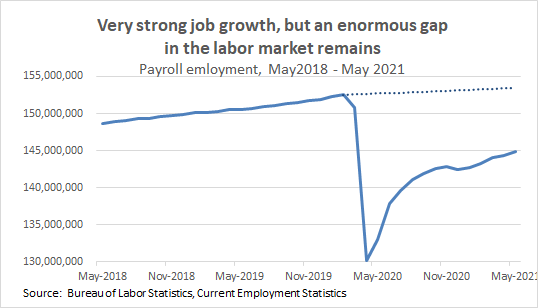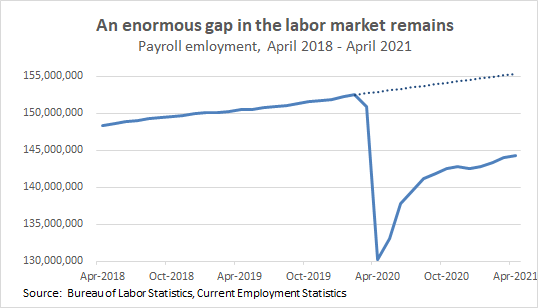
The labor market added 559,000 jobs in May, very strong growth in line with expectations. The unemployment rate dropped to 5.8%, and most of that drop was for “good” reasons, people getting jobs. 1/
However, we still have 7.6 million fewer jobs than we did before the recession, in February 2020. 2/
Further that 7.6 million is not the total gap in the labor market. Without COVID, we would have *added* jobs over the last 15 months as the working-age population grew. Taking that into account, the total gap in the labor market right now is at least 8.5 million jobs. 3/ 

What do today’s data reveal whether there is anything behind the widespread talk of worker shortages? 4/
Employment in leisure and hospitality (l&h) grew by 292,000. Over the last two months, l&h has added 620,000 jobs, roughly three-quarters of the economy-wide jobs added over that period. Folks this is just not signaling a massive labor supply shortage. 5/
A key footprint of labor shortages is wage growth. Employers who face real shortages of workers will respond by bidding up wages to attract those workers, and employers whose workers are being poached will raise wages to retain their workers, and so on. 6/
The aggregate wage growth measures released today are problematic due to pandemic composition effects. To address that, you can look at the wage growth of relatively homogenous groups: production and nonsupervisory workers, by sector. 7/
When you do that, you find that the evidence does NOT point to widespread labor shortages in today’s labor market. In the vast majority of the economy, wages are not growing in a way that suggests any hint of a shortage. 8/
The key exception is in leisure & hospitality, where wages of nonsupervisory workers have risen sharply enough to suggest an actual (if sector-specific) shortage. But when you look further, you find this is nothing to be concerned about. 9/
As I mentioned already, wage acceleration in leisure and hospitality doesn’t appear to have held back job growth at all. Job growth in that sector has been BY FAR the strongest of any sector. 10/
Further, the wages of typical workers in leisure and hospitality plummeted in the recession and have largely just regained their pre-COVID trend—i.e. they are now in the ballpark of where they’d be if COVID had never happened. 11/ 

And notably, weekly wages for typical workers in leisure and hospitality translate to annual earnings of $20,714, far (far) lower than in other sectors, even with the recent acceleration. Those increases are not going to create broad wage pressure. 12/
Also, “wages” as measured in these data INCLUDES TIPS. Recent wage growth in restaurants may not be largely from employers raising pay to attract workers, but from workers’ hourly tips—which plummeted during the downturn—normalizing as customers return.13/ epi.org/blog/what-if-i…
In other words, the decline in restaurant wages early in the pandemic, and the recent rebound, may largely be not from *employers* cutting wages early on and now raising them back up, but from *customers* leaving during the worst of the pandemic and now coming back. 14/
In sum: we don't see widespread labor shortages. In leisure & hospitality, earnings have grown enough to suggest a sector-specific shortage, but that may be largely the result of customers—and their tips—returning. It certainly wasn’t holding back job growth, which was robust.15/
This is very important.16/
https://twitter.com/WSpriggs/status/1400804727361839113?s=20
Job growth in State & Local government was strong (+78,000) but we need much, much more. We're still down 1.2 million S&L govt jobs since Feb ‘20—most of it (801,000) in education. It’s crucial S&L governments use their ARP funds to refill those jobs. 17/
Excellent thread with a bunch of #jobsday details. 18/
https://twitter.com/eliselgould/status/1400793263016235009?s=20
Always remember: our history & present of systemic racism hugely affect the labor market. B/c of occupational segregation, discrimination, & other disparities rooted in white supremacy, this crisis is hitting Black & Latinx workers far harder than white workers.19/
The Black unemployment rate was 9.1% in May, the Latinx unemployment rate was 7.3%, the Asian unemployment rate was 5.5%, and the white unemployment rate was 5.1%. 20/
• • •
Missing some Tweet in this thread? You can try to
force a refresh





